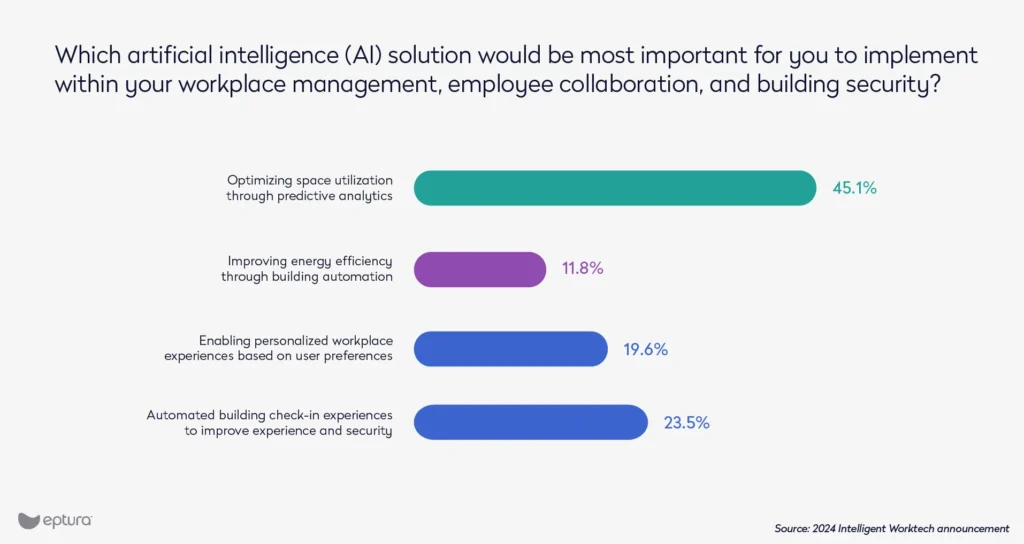
Innovations in worktech, including new ways of capturing and leveraging data, create new opportunities to optimize real estate portfolios. Large organizations are deciding which solutions will work best for them and where and when to implement them. The Intelligent Workplace product announcement was an opportunity for us to bring together and engage with industry leaders to share our vision of the technologies that will drive the future of work.
As part of our industry engagement, we took three polls during the event, and the results echo insights from earlier Eptura research, supporting the product development decisions we’ve made to best address industry-wide challenges and help organizations meet their specific goals across the enterprise.
The three questions covered key focus areas for facility and workplace leaders in attendance: The integrated workplace, the strategic use of building information modeling (BIM) data in facility and space management, and the role of artificial intelligence (AI) in enhancing facility operations. The polls also reveal interesting regional differences between the combined North America (NA) and Europe, Middle East, and Africa (EMEA) markets and the Asia and Pacific region (APAC).
By focusing on specific aspects like optimizing space utilization, improving energy efficiency, and integrating asset management with workplace strategies, operational leaders will be better equipped to help their organizations be successful amid continued change.
Enterprises around the world know data is important, but regional approaches to leveraging data differ
By integrating multiple management tools into a single system, organizations can gain real-time visibility into space utilization, asset performance, and maintenance needs. Integrated facility management enables better coordination among teams, reducing redundancies and improving response times. A unified platform also helps facilitate data-driven decision-making by providing comprehensive analytics and insights, allowing for optimized resource allocation and cost savings. And by offering seamless access to services and amenities, it fosters a more productive and engaging workplace environment.
We asked attendees which of the following solutions would have the greatest impact on integrating asset management with workplace strategy:
- Integrated workplace, employee experience, and asset operations
- Connected data capture and real estate analytics in one place
- Integrated employee service request ticketing and maintenance work orders
- Space utilization pattern insights through network and sensor data
- Capital management and cost optimization tools
This question looked at interest in different types of integrations to help workplace and facility professionals support organizational goals. Based on previous research in the Workplace Index report, it’s clear that companies pass through set stages as they move toward a complete digital ecosystem. But along the way, not all companies plan to implement the same solutions in the same order.
While both NA/EMEA and APAC showed almost the same level of interest in “Connected data capture and real estate analytics in one place,” with 17.4% and 17.6%, suggesting a consistent understanding of the importance of data, there were differences in what kinds of data they thought would make the biggest difference to their overall organization. In NA/EMEA, the focus was on creating a holistic, seamless workplace, with “Integrated workplace, employee experience, and asset operations” at 33.8% and “Integrated employee service request ticketing and maintenance work orders” at 22.7%. Those numbers for APAC were smaller, just 25.5% and 15.7%.
Respondents in the APAC region showed more interest in “Space utilization pattern insights through network and sensor data,” with 29.4%, indicating a stronger focus on optimizing space usage and leveraging sensor data for better workplace planning.
NA/EMEA is already leveraging BIM in many ways, including space planning, tracking assets, and scenario simulations, while APAC tends to have more targeted focus: clash detection
Teams can use BIM data for space planning to deliver efficient and well-utilized spaces. BIM’s detailed, 3D digital models incorporate architectural, structural, and mechanical elements, enabling accurate visualization and analysis of existing conditions, empowering space planners to simulate various layouts, detect potential clashes, and optimize space usage.
By integrating BIM data with other tools, planners can perform occupancy simulations, daylight analysis, and energy efficiency assessments, leading to more informed decisions. A collaborative, data-driven approach enhances stakeholder communication, reduces errors, and streamlines the planning process.
Ultimately, leveraging BIM data results in spaces that are not only functional but also tailored to the specific needs and activities of their occupants, ensuring a more comfortable and productive environment.
The second poll question looked at how organizations are currently leveraging BIM data, and all the answers were statistically significant and had the largest differences of the poll responses.
We asked: What is the most important way you are using BIM data in your space planning processes?
- Analyze space utilization patterns
- Visualize dependencies between spaces and assets
- Clash detection during the design phase between elements such as walls, pipes, equipment, etc.
- Track asset lifecycles from design and construction to operation and maintenance
- Scenario-based simulations to test different space layouts, occupancy scenarios, and asset configurations
- I’m not currently using BIM data
Overall, respondents in the NA/EMEA regions appear to have embraced BIM for facility management much more fully than those in the APAC region. For overall space utilization analysis, NA/EMEA was 30.1%, while APAC was 12%. For tracking asset life cycles, NA/EMEA was 28%, while APAC was only 16%.
And while those in the NA/EMEA regions said they were using it in some way, 28% of respondents in APAC said they were not using BIM data at all.
This indicates a significant area of opportunity for organizations facilitated by new innovations in worktech. For example, with the ability to use digital twin technology within their building and asset operational systems without Revit or 3D CAD training, space planners will be able to deliver space planning reports and occupancy management without needing a specialist in building design programs.
With a unified visualization of the built environment, including all its systems, space planners will be able to more easily:
- Assign space to maximize utilization and support productivity
- Manage dependencies between assets and space
- Plan efficient moves and seating arrangements
Organizations can also use these digital models for sustainability initiatives that often come with complex challenges for larger companies spread out across multiple legal and regulatory jurisdictions.
Both regions like AI for boosting overall experience, but in different ways. For APAC, there’s room to grow
An AI-backed solution can significantly enhance workplace management, employee collaboration, and building security. In workplace management, AI can automate routine tasks like scheduling meetings and managing workloads, freeing up employees’ time for more strategic work. Workplace and facility managers can leverage it to analyze data to predict trends and provide insights on everything from energy use to preventive maintenance planning.
In building security, AI can greatly improve access control by streamlining the check-in process, making it more efficient and secure. And when an organization integrates it with Internet of Things (IoT) devices, AI can also monitor and control environmental conditions like temperature and lighting, ensuring optimal working conditions while reducing energy consumption.
We asked which AI solution would be most important for attendees to implement within their workplace management, employee collaboration, and building security out of the following options:
- Optimizing space utilization through predictive analytics
- Improving energy efficiency through smart building automation
- Enabling personalized workplace experiences based on user preferences
- Automated building check-in experiences for visitors, creating a smoother experience and better security
The numbers for delivering personalized workplace experiences and automating building check-in were close. In fact, they “mirrored” one another.
“Enabling personalized workplace experiences based on user preferences” was 23.1% for the NA/EMEA regions and 19.6% for the APAC region. “Automated building check-in experiences for visitors, creating a smoother experience and better security” was 18.7% for NA/EMEA and 23.5% for APAC. An example of using AI for a personalized employee experience is desk booking solutions that have AI automatically allocate desks that meet their needs, grouping teams or frequent collaborators together.
Overall, AI was the one area the two regions had the closet answers, and globally, the most popular choice was optimizing space utilization through predictive analytics, which involves using data-driven insights to efficiently manage and allocate physical spaces.
Facility and workplace professionals can use AI to analyze historical data and generate predictive models to forecast future space needs, allowing them to make informed decisions about space management.
By analyzing patterns in space usage, predictive analytics can help identify underutilized areas, predict peak usage times, and suggest optimal configurations that maximize space efficiency, enhancing operational efficiency but also reducing costs and improving the overall workplace environment.
Predictive analytics can be particularly beneficial in dynamic settings like office buildings, educational institutions, and healthcare facilities, where space demand can fluctuate significantly.
These results are reflective of a growing understanding across the industry that data — and how well you can capture, combine, and leverage it — is key to achieving organizational goals. In fact, the results echo the numbers from the Workplace Index report, where workplace and data analytics were the most common answers to the question “Moving ahead over the next 12 months, what technology are you looking to deliver?”
The future of intelligent worktech is unified
At the Intelligent Worktech product announcement, Fabrice Martin, Chief Product Officer at Eptura, described the challenge many now face: Many organizations have good data, but it’s siloed, reducing its value.
The solution is a platform that brings it all together. Learn more about how Eptura is making this a reality.






